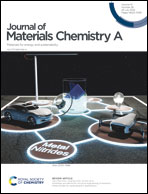A novel porous graphitic carbon nitride (g-C7N3) substrate: prediction of metal-based π–d conjugated nanosheets toward the highly active and selective electrocatalytic nitrogen reduction reaction†
Abstract
The two-dimensional (2D) graphitic carbon nitride skeleton offers rich hollow sites for stably anchoring transition-metal (TM) atoms to promote single-atom catalysis, which is expected to overcome the great challenges of low activity and selectivity for ammonia synthesis resulting from the sluggish activation of inert N2 and the competitive hydrogen evolution reaction (HER). Very recently, a novel holey graphitic carbon nitride monolayer with the C7N3 stoichiometric ratio (g-C7N3) was proposed, whose Dirac dispersion located at the Fermi level rightly provides excellent electric conductivity for achieving the high-performance nitrogen reduction reaction (NRR). Herein, first-principles calculations within the density-functional theory were performed to examine the feasibility of a single TM-atom (from Sc to Au) supported on g-C7N3 as π–d conjugated single-atom catalysts (SACs) for NRR. Through a “Five-step Procedure” screening strategy, Hf, Ta, W and Re@g-C7N3 were highlighted from 27 TM@g-C7N3 as the best SACs for NRR with low limiting potentials of −0.06 to −0.46 V. Particularly, the two systems, Ta@g-C7N3 and W@g-C7N3, possess well-HER-suppressed ability due to smaller NRR-kinetic barriers as compared with those of HER and, impressively, together with their rather low limiting potentials of −0.27/−0.27 and −0.22/−0.06 V under end-on/side-on pattern, respectively, they may exceed most NRR catalysts reported previously. Moreover, multiple-level descriptors have been developed to uncover the origins of NRR activity, among which a 3D volcano plot (screening strategies, limiting potentials, and electronic origins) shows the activity trends of NRR, achieving a fast prescreening among various candidates. This work not only accelerates the discovery of catalysts for nitrogen fixation but also contributes to broadening the understanding of single-atom catalysis.



 Please wait while we load your content...
Please wait while we load your content...